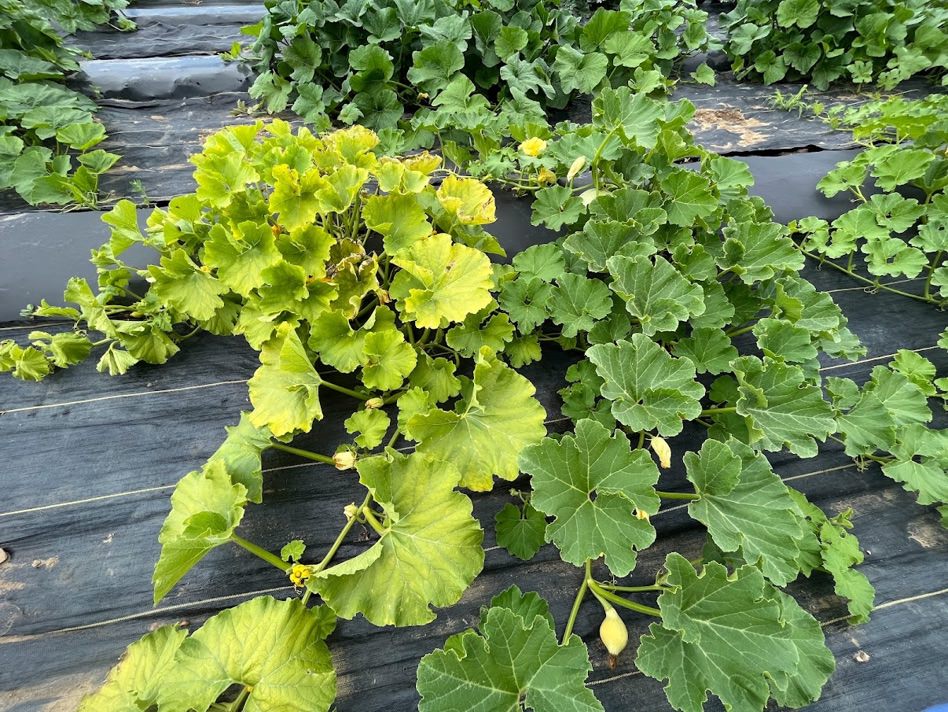Introduction
Cucurbit yellow vine disease (CYVD) is an emergent disease in the United States caused by the bacterium Serratia ureilytica, and it commonly affects zucchini, squash, watermelon, and melons. The pathogen that causes CYVD is transmitted by the squash bug (Anasa tristis, Figure 1), and other potential vectors include the striped cucumber beetle (Acalymma vittatum) and spotted cucumber beetle (Diabrotica undecimpunctata). Common symptoms of CYVD are yellowing of leaves and vines, stunting, and scorching of leaf margins (Figure 2). When looking at the cross-section, some plants will have discoloration in the vascular tissues (phloem).

Figure 1. Squash bug stages. Adult squash bug (A). Nymphal stages of squash bug (B). Squash bug egg mass (C) (Photos by Kensy Rodriguez).

Figure 2. Typical symptoms of cucurbit yellow vine disease on a squash field. Symptomatic plant (left) and healthy plant (right) (Photo by Kensy Rodriguez).
In Indiana, CYVD has not been reported officially; however, in conversations with the PPDL personnel, we concluded that the causal agent of this disease was isolated from several cucurbits. The symptoms described above can easily be confused with those caused by nutrient deficiency or other bacterial diseases, such as bacterial wilt. This year, we want to monitor the pathogen’s presence in Indiana’s cucurbits fields. If you observe plants showing symptoms similar to those caused by CYVD, please contact Cesar Escalante to arrange a field visit or submit samples for analysis.
Disease cycle
Squash bug adults can overwinter with the bacterium in their bodies and infect a cucurbit plant by feeding on it. Secondary infections happen when squash bugs that do not carry Serratia ureilytica acquire the bacterium by feeding on an infected plant, later feeding on a healthy plant, and transmitting the pathogen. Symptoms can be expressed as early as one week after transmission; however, symptoms can take up to four weeks to appear.
Management
Management strategies for CYVD rely on controlling the vectors. Cultural practices, such as reducing crop debris and old fruit, can help reduce the pest population for the next season. Crop trapping is a commonly used method that involves planting an attractive variety of crops before planting the crop, or planting them at the edges, which can help reduce the incidence of insects in the main plot. Zucchini and Hubbard winter squash can be good crop trapping options.
Row cover at the beginning of the season is an effective method to keep squash bugs and cucumber beetles from feeding on the plants, and it can be removed before pollination time. Insecticides are also a standard method for managing squash bugs and cucumber beetles. Ensure the products you are trying to use are registered for the pest and host you plan to use them on. For specific active ingredients and product names, consult the Midwest Vegetable Production Guide or contact your local Extension Educator or Specialist.
Additional resources
Cornell SIPS. 2023. Vegetable Pests and Diseases: Cucurbit Yellow Vine Disease (CYVD). YouTube video. https://www.youtube.com/playlist?list=PLHPXm2Es8aQC-bvlhKF45KvDlnV6xLIBd
Midwest Vegetable Production Guide. 2025. https://mwveguide.org/guide